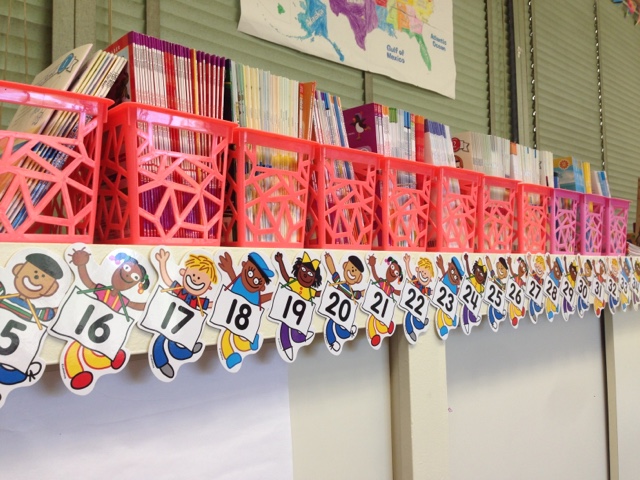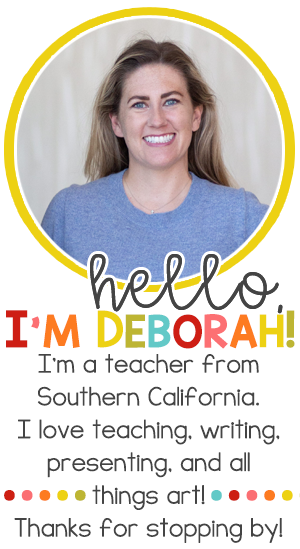First of all: I call the student who leads calendar each day our Meteorologist of the Day. I like using a rich vocabulary with the kids, so instead of saying "Weather Person," we say "Meteorologist." Yes, I know, there are plenty of components to this daily routine that have nothing to do with the weather. But that's just how we do it in Room 1. The Meteorologist of the Day wears many hats. :)~ CALENDAR SECTION ~
The Meteorologist of the Day begins Calendar time by reciting in front of class: "Today is [Wednesday, November 18, 2015]. Yesterday was [Tuesday, November 17, 2015]. [Tomorrow will be Friday, November 19, 2015]."
Optional, depending on time: I will say to the student: "Tell the class about something that happened yesterday (in the past), something that is happening today (in the present), or something that will happen tomorrow (in the future), without telling the class exactly when this thing happened, and we're going to guess if it happened yesterday, is happening today, or will happen tomorrow." {Example: "I went to the movies."} Teacher will ask the rest of the class to figure out if the event happened yesterday, is happening in the present, or will happen in the future. Ask them, "Which words in the sentence were clues that let you know this?" {Guide them towards the word went, which is a past tense verb.}
- L.1.1e: Use verbs to convey a sense of past, present, and future (e.g., Yesterday I walked home; Today I walk home; Tomorrow I will walk home).
~ WEATHER SECTION ~
The Meteorologist determines which words describe the day's weather, with help from the class if needed. Have student look for, select, and place (for example,) sunny and windy word cards on the wall to finish the sentence on the board. Student will then recite aloud for the class, pointing to each word as he/she reads: "The weather today is [sunny and windy]."
- RF.1.3: Know and apply grade-level phonics and word analysis skills in decoding words.
- RF.1.3g: Recognize and read grade-appropriate irregularly spelled words
The Meteorologist of the Day will mark the weather graph with a dry-erase marker, putting a check or an X in the windy column and the sunny column. {
I am aware that by allowing students to mark the graph with more than one type of weather a day, you can no longer ask questions about the graph that revolve around the total number of days you've charted. This is okay with me.}The teacher will ask the Meteorologist questions about the graph, and
require him/her to say the answer in a complete sentence. I start off the year with the types of questions in the "Easier" section below, and then transition up to the "Challenge" level questions by the end of the year.
Ask the Meteorologist to
explain how he/she got their answer. Some students will tell me the number sentence they used, others will explain how they visually used the graph. As long as it makes sense, I'm good with it.
Easier Question Examples:
How many days has it been rainy this month? What kind of weather have we had the most of this month? What kinds of weather have we had the least?
Harder Question Examples:
How many more days has it been sunny than rainy this month? How many days fewer has it been cloudy than windy?
Challenge Question Examples:
How many more days has it been sunny than windy and cold put together? If it rains tomorrow, how many more days will it have been rainy than snowy?- 1.MD.4: Organize, represent, and interpret data with up to three categories; ask and answer questions about the total number of data points, how many in each category, and how many more or less are in one category than another.
~ DAYS OF SCHOOL ~
The Meteorologist reads the following card: "How many days have we been in school?" and then tell the class how many days we were in school as of yesterday.
Add one more straw to the place value pockets: Ensure the student places the straw in the ONES pocket, not the tens or hundreds. Then take out all the tens and ones, and count them aloud and he/she places them back in the proper pocket. (E.g., "Ten, twenty, thirty, forty, fifty, sixty, sixty-one, sixty-two, sixty-three. We've been in school sixty-three days this year.")
- 1.NBT.1: Count to 120, starting at any number less than 120. In this range, read and write numerals and represent a number of objects with a written numeral.
- 1.NBT.2: Understand that the two digits of a two-digit number represent amounts of tens and ones. Understand the following as special cases:
- a. 10 can be thought of as a bundle of ten ones - called a "ten."
- b. The numbers from 11 to 19 are composed of a ten and one, two, three, four, five, six, seven, eight, or nine ones.
- c. The numbers 10, 20, 30, 40, 50, 60, 70, 80, 90 refer to one, two, three, four, five, six, seven, eight, or nine tens (and zero ones).
Ask the Meteorologist questions related to the current number of days of school. (E.g., In ten more days, how many days will we have been in school? In thirty more days, how many days will we have been in school? How many more days until we get to the seventieth day of school?)
*Keep the rest of the class engaged by asking them to give the Meteorologist a silent thumbs up if they agree with his/her answer. I also remind them that they need to pay attention, because the Meteorologist might need help, and can call on helpers from the rug who are quiet to help with the answer.
- 1.NBT.4: Add within 100, including adding a two-digit number and a one-digit number, and adding a two-digit number and a multiple of ten, using concrete models or drawings and strategies based on place value . . .
- 1.NBT.5: Given a two-digit number, mentally find 10 more or less than the number, without having to count; explain the reasoning used.
Add one more coin to the money pocket chart: Ask the student which coin he/she needs to add to the chart. When he/she tells you a penny, ask, "And why are you choosing a penny to show one more day of school?" The student will nearly always just say, "Because it's worth one." If they don't tell me it's worth one cent, I reply, "One dollar?!?" And then they laugh, and correct me, and say, "No, the penny is worth one cent!" The Meteorologist of the Day then leads the class in counting the coins to make sure we have the same number of cents as we do in the straw pockets.
{Note: I do have a half-dollar shown with my the other coins as an example of US currency, but when it comes to adding coins to our "Days of School" count, I ask students to use two quarters to show fifty cents instead of the half-dollar. I explain to the class that half-dollars are rare, and the majority of grown-ups don't pay for things with half-dollars. I would rather they internalize the fact that two quarters make fifty cents (and when we get to the seventy-fifth day of school, that three quarters make seventy-five cents).}
Ask if we can exchange any coins to have a lesser number of coins shown (keeping in mind, most days we can't!). The kiddos love showing equivalent values of coins, and it's for this reason that kids love being Meteorologist when we get to a day of school that lands on a multiple of five. I know the Common Core no longer requires firsties to learn about money, but I think it's important, so I still teach it anyway.
- 2.MD.8: Solve word problems involving dollar bills, quarters, dimes, nickels, and pennies, using dollars and cents symbols appropriately.
After determining that we are showing the correct coins in the pocket chart, the Meteorologist will write the number sentence showing the addition of each coin to get the sum of days we've been in school. (E.g., 25 + 25 + 10 + 1 + 1 + 1 = 63).
Add one more base-ten block: The Meteorologist will then add one more base-ten block to our base-ten representation of the days we've been in school. I used velcro tape on a small white board, and on the backs of a handful of base-ten blocks, so the students can simply stick them up on the wall for everyone to easily see. Like with the straws, and needing to make a bundle of ten when adding the tenth one, the student will exchange the ten one-cubes for a long ten when necessary.
- 1.NBT.1: Count to 120, starting at any number less than 120. In this range, read and write numerals and represent a number of objects with a written numeral.
- 1.NBT.2: Understand that the two digits of a two-digit number represent amounts of tens and ones. Understand the following as special cases:
- a. 10 can be thought of as a bundle of ten ones - called a "ten."
- b. The numbers from 11 to 19 are composed of a ten and one, two, three, four, five, six, seven, eight, or nine ones.
- c. The numbers 10, 20, 30, 40, 50, 60, 70, 80, 90 refer to one, two, three, four, five, six, seven, eight, or nine tens (and zero ones).
Add the Numbered Lakeshore Little Person: Finally, the Meteorologist will finish our Calendar session by showing everyone the "Little Person" (as they call them) for that day's number. I used to put them up along the metal boarder of our bulletin board, but it made it too hard to change bulletin board backings each season. (I'd have to take down every. single. one. each time I wanted to change paper or borders, and then put each. one. back. up. It would take FOREEEVVVERRR.) So now I tape our little people along the top of my cabinets on a different wall. I miss having them with the rest of our calendar, but I had to choose my sanity over OCD.
~ TO SUM UP ~
I know this feels like a VERY LONG calendar routine. (It actually used to be longer, because we used to sing songs for the days of the week and the months of the year. I cut them, for the sake of time.) Start to finish, however, the whole routine really only takes about fifteen minutes. Once the kids get the hang of it, they lead the class through each part, start to finish. All I need to do is ask the Meteorologist his/her questions about the data along the way. We're like a well-oiled machine!






































